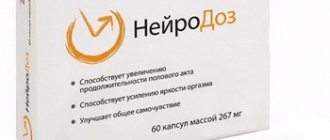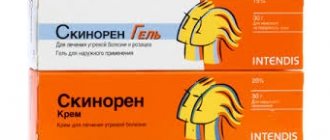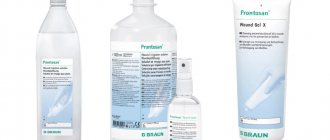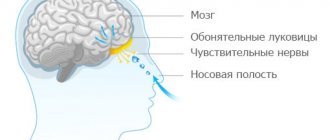Release forms and composition of the drug
The medicine is produced in the form of effervescent soluble tablets. Their main active ingredient is ibuprofen.
Additional components:
- 0.3 g potassium carbonate;
- 0.01 g anhydrous sodium carbonate;
- 0.33 g citric acid;
- 0.29 g monosodium citrate;
- 1.34 g sodium bicarbonate;
- 0.04 g sodium saccharinate;
- 0.01 g sucrose palminate;
- 0.01 g menthol flavoring;
- 0.04 g flavoring (grapefruit flavor);
- magnesium stearate – until the capsule weight is 2.8 g.
The product is packaged in aluminum strips and packaged in cardboard boxes.
Pharmacological properties
The medicine is a derivative of phenypropionic acid. It belongs to the class of non-steroidal anti-inflammatory drugs (NSAIDs). The action of the components of the drug is aimed at suppressing and inhibiting the production of cyclooxygenase. The enzyme is a precursor of prostaglandins and is involved in the development of inflammatory reactions, pain and fever.
The analgesic effect is achieved by inhibiting the synthesis of prostaglandins in the central nervous system. In this case, a decrease in platelet aggregation is observed. The main components eliminate signs of joint stiffness and increase motor function in the joints.
Pharmacodynamics and pharmacokinetics
When administered orally, the active component of the drug is almost completely absorbed from the gastrointestinal tract. In this case, there is a decrease in absorption capacity while eating food.
The main substance is metabolized mainly in the liver - about 90%. The half-life of metabolites is 2-3 hours. Approximately, about 80% of the dosage of the drug is excreted in the urine in the form of metabolites. About 10% of the components are excreted from the body unchanged. 20% of the drug dosage is excreted through the intestines in the form of metabolites.
Indications and pharmacological properties
Advil has analgesic, antipyretic and anti-inflammatory effects . Inflammation often causes pain, in which case the analgesic properties are very important to ensure an easier course of the disease.
As follows from the instructions for use of Advil capsules, the drug is suitable for use for toothache and headaches , and is also indicated for pain in the back and muscles , and can be prescribed by a doctor for inflammation of the joints and problems with the spine.
Depending on the specific disease, the dosage of the drug is selected individually. The single dose for oral administration is 800 mg. You usually need to take Advil 5 times a day. Schoolchildren over 12 years of age are prescribed a dosage of 400 mg 3 times a day.
The medication is allowed to be given to small children from 3 months to 1 year. In this case, the daily intake should be 50 mg. Children over 3 years old are prescribed 50 mg of the drug 3 times a day. For febrile syndrome, the dosage can be increased to 70 mg, taking into account that the maximum daily dose should not exceed 120 mg.
Infants are given suppositories every 8 hours. The total amount of medication per day is 180 mg. There are the following contraindications:
- The drug is prohibited for ulcerative-erosive diseases of the digestive tract.
- If you have eye diseases, severe bleeding, or problems with the liver or kidneys, you should also not use this medicine.
- Advil should be discontinued if you are hypersensitive to ibuprofen.
Side effects may include severe dizziness, blurred vision, and headache. In addition, sleep and kidney function may be disrupted.
Indications for use
Advil is an American tablet that is often prescribed as part of a complex treatment of degenerative and inflammatory processes in the joints.
Indications:
- rheumatoid arthritis;
- rheumatoid arthritis;
- presence of osteoarthritis;
- relapses of gout accompanied by joint disorders;
- bursitis;
- radiculitis;
- ankylosing type of spondylitis;
- development of tendinitis;
- inflammatory processes in the area of soft tissues and the musculoskeletal system caused by various injuries.
The medication is also used in the treatment of infectious and inflammatory processes in the ENT organs: adnexitis, algodismenorrhea, pain syndrome. The drug exhibits a therapeutic effect against headaches, toothaches, and feverish conditions caused by infectious and inflammatory processes.
Contraindications
The medicine is contraindicated in the presence of hypersensitivity to the main component, as well as during pregnancy (3rd trimester).
Additional contraindications:
- kidney and liver dysfunction;
- disorders in the hematopoietic system;
- lesions in the area of the optic nerve;
- the presence of erosions and ulcers in the gastrointestinal tract during an exacerbation;
- asthmatic triad.
The drug can be prescribed during breastfeeding only with the permission of the treating specialist.
Use during pregnancy and lactation
Taking the medication is prohibited during the 3rd trimester of pregnancy. At earlier stages, its use is possible in case of urgent need, and the pregnant woman should be under the constant supervision of a doctor.
If the medication is used while breastfeeding, its components will pass into the milk, so it is permissible to take the drug only in small doses.
In case of a large dosage, the baby is transferred to artificial nutrition. Advil should not be given to infants under 3 months of age.
Instructions for use, dosage of the drug
Advil - American tablets that must be used according to the instructions of a specialist or the recommendations noted in the instructions. The dosage is selected individually according to the established form of the disease and clinical manifestations.
American Advil tablets are very expensive compared to domestic ibuprofen
- When taking capsules orally, a single dosage should not exceed 0.2-0.8 g. Take 3-4 times a day.
- In childhood, the dosage is calculated according to the child’s weight - 20 mg/kg/day several times a day.
- When used externally, the duration of therapy varies between 2-3 weeks.
The maximum permissible dose per day is no more than 2.4 g.
Directions for use and dosage of Advil
Advil tablets, according to the instructions, are taken orally after meals.
The dosage of the drug depends on the type of disease and the severity of its course. As a rule, they prescribe:
- For pain – 1-2 tablets of Advil 400 mg three times a day. Maximum – 2.4 g per day;
- For rheumatoid arthritis - 2 tablets containing 800 mg three times a day;
- For sprains and soft tissue injuries - 400 mg two to four times a day;
- For juvenile rheumatoid arthritis - at the rate of 30-40 mg per kilogram of body weight per day, dividing the total amount into several doses;
- For ankylosing spondylitis and osteoarthritis - 1 Advil tablet containing 400 mg of ibuprofen, three or four times a day;
- To reduce body temperature, if it does not reach 39.2 ºС - at the rate of 5 mg per kilogram of body weight per day, if above 39.2 ºС - at the rate of 10 mg/kg per day.
The dosage of Advil for children is calculated based on their weight: 20-40 mg per kilogram of the child’s weight, divided into 3-4 doses during the day. To reduce elevated body temperature, the dose of Advil is calculated in the same way as for adults.
Side effects
The drug can cause various side effects related to the physiological characteristics of the patient.
Side effects:
- From the digestive system: discomfort in the abdomen, nausea and vomiting, diarrhea, formation of erosions and ulcers in the gastrointestinal tract, bleeding; in rare cases, functional liver disorders may develop.
- From the nervous system: dizziness and headaches, increased excitability, sleep disorders, decreased visual ability.
- From the hematopoietic system: development of anemic syndrome; agranulocytosis, thrombocytopenia.
- From the urogenital tract: functional disorders of the kidneys.
- Allergic signs: rashes, Quincke's edema, spasms in the bronchi, aseptic form of meningitis.
- Local manifestations: possible development of hyperemia, burning sensation and unpleasant tingling.
If reactions develop that are not noted in the instructions, you should consult a specialist.
Avifavir, 200 mg, film-coated tablets, 10 pcs.
This medicinal product is registered according to the registration procedure for drugs intended for use in conditions of the threat of occurrence, occurrence and elimination of emergency situations. The instructions have been prepared on the basis of a limited amount of clinical data on the use of the drug and will be supplemented as new data become available. The use of the drug is possible only in inpatient medical care.
The use of the drug is possible only in inpatient medical care. If a side effect develops, it is necessary to report this in the prescribed manner for the implementation of pharmacovigilance activities.
Before starting to take the drug AVIFAVIR, it is necessary to provide written information to the patient about the effectiveness of the drug and the risks associated with its use (including the risk of effects on the embryo and fetus) and obtain written consent to use the drug.
Because fetal death and teratogenicity were observed in animal studies of favipiravir, AVIFAVIR should not be administered to pregnant or suspected pregnant women.
1) When prescribing AVIFAVIR to women capable of childbearing (including those less than 2 years postmenopausal), it is necessary to confirm a negative pregnancy test result before starting treatment. Women of childbearing potential should be fully explained the risks and carefully instructed to use the most effective method of contraception with their partners while taking the drug and for 1 month afterwards (condom with spermicide). If you suspect a possible pregnancy, you should immediately stop taking the drug and consult your doctor.
2) When distributed in the human body, the drug AVIFAVIR enters the sperm. When prescribing the drug to male patients, the risks should be fully explained and carefully instructed to use the most effective methods of contraception during sexual intercourse while taking the drug and for 3 months after its end (condom with spermicide). Additionally, male patients should be instructed not to have sexual contact with pregnant women.
3) When distributed in the human body, the drug AVIFAVIR passes into breast milk. When prescribing the drug, breastfeeding women should be fully explained the risks and carefully instructed to stop breastfeeding while taking the drug and for 7 days after it ends.
Impact on the ability to drive vehicles and operate machinery
Care should be taken when driving vehicles and operating machinery.
Overdose
Tablets that exceed the specified dose can cause various negative manifestations. In this regard, it is recommended to strictly adhere to the dosage prescribed by the American manufacturer, specified in the official instructions for Advil.
Symptoms of drug overdose are associated with signs of ibuprofen overdose: nausea and vomiting, drowsiness, dizziness, abdominal pain, low blood pressure, renal and hepatic disorders, acidosis.
In rare cases, a decrease in pressure, confusion or loss of consciousness is observed, respiratory depression is noted, convulsions and hyperkalemia develop.
Drug interactions
The drug reduces the therapeutic effect of diuretics, as well as drugs aimed at treating hypertension. There is an increase in the effect of anticoagulants with simultaneous use of capsules.
The combined use of tablets and glucocorticosteroids leads to the risk of side effects from the gastrointestinal tract. The medication prevents the processes of binding the active substances of drugs belonging to the group of anticoagulants, hypoglycemic agents, and hydantoin derivatives.
Concomitant use with amlodipine leads to a decrease in the therapeutic effectiveness of the antihypertensive drug.
Other interactions:
- Aspirin - decreases the concentration of the active component of Advil.
- Baclofen – toxic effects.
- Warfarin – increased bleeding time, hematoma formation, microhematuria.
- Captopril – decreased antihypertensive activity.
- Metatrexate – increased toxicity.
- Colesteramine – reduces the absorption time of the active component.
Lithium preparations temporarily increase the concentration of the substance in the blood. The level of absorption of ibuprofen increases with simultaneous use of the drug with magnesium hydroxide.
Advil®
Should be avoided
simultaneous use of ibuprofen with the following drugs:
- Acetylsalicylic acid: except for low doses of acetylsalicylic acid (no more than 75 mg per day) prescribed by a doctor, since concomitant use may increase the risk or other NSAIDs may increase the risk of side effects. With simultaneous use, ibuprofen reduces the anti-inflammatory and antiplatelet effect of acetylsalicylic acid (an increase in the incidence of acute coronary insufficiency in patients receiving small doses of acetylsalicylic acid as an antiplatelet agent is possible after starting ibuprofen).
- Other NSAIDs, in particular selective COX-2 inhibitors: simultaneous use of two or more drugs from the NSAID group should be avoided due to a possible increased risk of side effects.
Carefully
The drug should be used simultaneously with the following medications.
- Anticoagulants and thrombolytic drugs: NSAIDs may enhance the effect of anticoagulants, in particular warfarin and thrombolytic drugs.
- Antihypertensive drugs (ACE inhibitors and angiotensin II antagonists) and diuretics: NSAIDs may reduce the effectiveness of drugs in these groups. In some patients with impaired renal function (eg, dehydrated patients or elderly patients with impaired renal function), coadministration of ACE inhibitors or angiotensin II antagonists and COX-inhibiting agents may result in a deterioration of renal function, including the development of acute renal failure. (usually reversible). These interactions should be considered in patients taking coxibs concomitantly with ACE inhibitors or angiotensin II antagonists. In this regard, the combined use of the above drugs should be prescribed with caution, especially in the elderly. Patients should be prevented from dehydration and consideration should be given to monitoring renal function upon initiation of this combination treatment and periodically thereafter. Diuretics and ACE inhibitors may increase the nephrotoxicity of NSAIDs.
- Glucocorticosteroids: increased risk of gastrointestinal ulcers and gastrointestinal bleeding.
- Antiplatelet agents and selective serotonin reuptake inhibitors: increased risk of gastrointestinal bleeding.
- Cardiac glycosides: simultaneous administration of NSAIDs and cardiac glycosides can lead to worsening heart failure, a decrease in glomerular filtration rate and an increase in the concentration of cardiac glycosides in the blood plasma.
— Lithium preparations: there is evidence of the likelihood of an increase in the concentration of lithium in the blood plasma during the use of NSAIDs.
- Methotrexate: there is evidence of the likelihood of an increase in the concentration of methotrexate in the blood plasma during the use of NSAIDs.
- Cyclosporine: increased risk of nephrotoxicity with simultaneous administration of NSAIDs and cyclosporine.
- Mifepristone: NSAIDs should be started no earlier than 8-12 days after taking mifepristone, as NSAIDs may reduce the effectiveness of mifepristone.
- Tacrolimus: when NSAIDs and tacrolimus are co-administered, the risk of nephrotoxicity may increase.
— Zidovudine: simultaneous use of NSAIDs and zidovudine may lead to increased hematotoxicity. There is evidence of an increased risk of hemarthrosis and hematomas in HIV-positive patients with hemophilia who received concomitant treatment with zidovudine and ibuprofen.
- Quinolone antibiotics: in patients receiving concomitant treatment with NSAIDs and quinolone antibiotics, the risk of seizures may increase.
— Myelotoxic drugs: increased hematotoxicity.
— Cefamandole, cefoperazone, cefotetan, valproic acid, plicamycin: increased incidence of hypoprothrombinemia.
- Drugs that block tubular secretion: decreased excretion and increased plasma concentrations of ibuprofen.
— Inducers of microsomal oxidation (phenytoin, ethanol, barbiturates, rifampicin, phenylbutazone, tricyclic antidepressants): increased production of hydroxylated active metabolites, increased risk of developing severe intoxications.
— Microsomal oxidation inhibitors: reducing the risk of hepatotoxicity.
— Oral hypoglycemic drugs and insulin, sulfonylurea derivatives: increased effect of drugs.
- Antacids and cholestyramine: decreased absorption.
— Uricosuric drugs: decreased effectiveness of drugs.
- Estrogens, ethanol: increased risk of side effects.
— Caffeine: increased analgesic effect.
Analogs
Advil are American tablets that have several structural analogues and are often replaced by other drugs that have a similar therapeutic effect.
| Analogue name | Features/Characteristics | Price |
| Baralgin | This medicine is based on metamizole sodium. The medication has anti-inflammatory, analgesic, antipyretic effects and is produced in the form of tablets or injection solution. The medicine is prescribed for infectious and inflammatory diseases accompanied by fever, pain and spasms. Baralgin is highly effective against radiculitis, osteochondrosis, arthritis, and myalgia. The medication is contraindicated for hepatic porphyria and lack of glucose. The dosage is calculated individually according to the disease and the age of the patient. | 160-1066 rub. |
| Ibuprofen | This pharmacological drug belongs to the class of propionic acid derivatives and is available in several dosage forms - for rectal use, intravenous administration, oral administration and external use. The drug is used for various infectious and inflammatory diseases, including radiculitis, myalgia, various forms of arthritis, osteochondrosis, ARVI, influenza, gout. The course of treatment is determined in each case separately. It is forbidden to use the product yourself, as there are extensive contraindications. | From 16 rub. |
| MIG 200 | This medical product has anti-inflammatory, antipyretic, analgesic effects and is available in capsule form. Drops are prescribed for pain caused by rheumatoid diseases, influenza, and acute respiratory viral infections. The drug is prescribed to adults and children over 12 years of age. The daily dosage is 1-2 capsules every 4-6 hours. The course of treatment is determined by a specialist. The medicine is prohibited for use in cases of peptic ulcers, bronchial asthma, liver and kidney pathologies, and heart failure. | 60-180 rub. |
Before changing the drug, you should consult a specialist.
Advil
Advil (ibuprofen) is a tablet NSAID for oral use. It has an analgesic, antipyretic effect, and prevents the development of inflammatory reactions. Non-selectively inactivates the enzyme cyclooxygenase types 1 and 2. Suppresses the production of nociceptive and proinflammatory mediators of inflammation. The analgesic effect of the drug develops according to a mechanism different from narcotic analgesics and is most pronounced in pain associated with inflammation. The therapeutic effect of the drug is maintained at a clinically significant level for 8 hours. Advil, as well as other NSAIDs, has an antiplatelet effect, i.e. prevents platelets from sticking together. Advil is well absorbed from the gastrointestinal tract. The time to reach peak blood concentration varies from 45 minutes to 1.5 hours. The presence of food contents in the gastrointestinal tract slightly slows down the absorption of the active component. The drug undergoes metabolic transformations in the liver. Elimination from the body occurs mainly through urine and, to a small extent, through feces. Advil is prescribed for mild to moderate pain with rheumatic pain, myalgia, headaches (including migraines), dental pain, spinal pain, arthralgia, algodismenorrhea, as well as flu and cold symptoms. The drug is not used for individual intolerance to the active or auxiliary components, acetylsalicylic acid (aspirin) and other NSAIDs, erosive and ulcerative lesions of the stomach and duodenum, blood clotting disorders, severe liver and kidney diseases, 3rd trimester of pregnancy. In pediatric practice, Advil is used starting from the age of 12. A single dose of the drug is 1 tablet (for patients of all age groups, including the elderly and children over 12 years of age). The maximum daily dose is 3 tablets. The minimum interval between doses is 4 hours.
If after a three-day medication course the patient still has signs of fever or the condition worsens, it is necessary to stop taking the drug and consult a doctor. The same should be done if the pain persists or worsens after 10 days of taking Advil. Advil is not recommended to be combined with other NSAIDs to avoid increasing the risk of side effects. Advil weakens the effect of antihypertensive drugs (including calcium antagonists, ACE inhibitors). When taking Advil for a long time together with drugs that reduce gastric acidity, it must be borne in mind that the latter may reduce the absorption of ibuprofen. When taking Advil and glucocorticosteroids simultaneously, the risk of bleeding in the gastrointestinal tract increases. Advil weakens the effect of thiazide diuretics. Caffeine potentiates the analgesic effect of the drug. Preparations based on ibuprofen, incl. Advil may cause allergic reactions, including skin redness, rashes, or blisters. In people who suffer from bronchial asthma or have a history of this disease, Advil can provoke acute narrowing of the bronchi caused by muscle contraction. The risk of adverse reactions can be reduced by using the minimum effective amount of the drug and reducing the duration of pharmacotherapy. Elderly patients taking Advil, as well as other NSAIDs, should closely monitor their condition and immediately report to their doctor any symptoms (primarily gastrointestinal bleeding) that occur during the course of medication. If there are traces of blood in the feces, the drug should be stopped immediately. During the medication course, it is recommended to avoid consuming ethanol-containing products. During treatment (especially if we are talking about long-term pharmacotherapy), it is necessary to organize regular monitoring of peripheral blood parameters and functional activity of the liver and kidneys.









